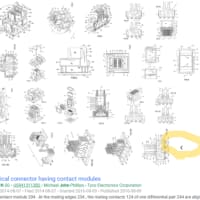WO2018226954
[0068] In some embodiments, a first parasitic element 915 may be positioned at least partially within the antenna volume.
【0059】
[0068]いくつかの実施形態では、第1の無給電素子915が、少なくとも部分的にアンテナボリューム内に位置決めされ得る。
A first active tuning element 916 may be coupled with the parasitic element 915.
第1のアクティブ同調素子916が、無給電素子915と結合され得る。
The first active tuning element 916 can be a passive or active component or series of components
第1のアクティブ同調素子916は、パッシブコンポーネントもしくはアクティブコンポーネントまたは連続コンポーネントとすることができ、
and may be configured to alter a reactance on the first parasitic element 914 either by way of a variable reactance, or shorting to ground, resulting in a frequency shift of the antenna.
可変リアクタンス、またはグランドへの短絡のいずれかによって第1の無給電素子914に対するリアクタンスを変更し、結果として、アンテナの周波数シフトを引き起こすように構成され得る。
WO2018208894
[0084] In some embodiments, the transmitter pad 200 includes a metal patch element 306 for each antenna element.
[0084] いくつかの実施形態において、送信器パッド200は、各アンテナ素子に関する金属パッチ素子306を含む。
The feed element 307 drives the corresponding patch element 306.
給電素子307は、対応するパッチ素子306を駆動する。
For example, the first patch element 306-A is driven by a first feed element 307-A and the second patch element 306-B is driven by a second feed element 307-B.
例えば、第1パッチ素子306-Aは第1給電素子307-Aによって駆動され、第2パッチ素子306-Bは第2給電素子307-Bによって駆動される。
The feed element 307 may be made from any suitable material known by those skilled in the art (e.g., aluminum, copper, etc.).
給電素子307は、当業者に既知である任意の適当な材料(例えばアルミニウム、銅など)から製作され得る。
WO2018052994
A way to improve the radiated power at/or near resonance in such cases is
このような事例での共振時又は近共振での放射電力を改善する方法は、
to use a parasitic element of sufficiently matched impedance to the unit cell which facilitates splitting the strong resonating current near the unit cell,
単位セルに十分に整合したインピーダンスの無給電素子を用いることであり、単位セル近傍で強い共振電流の分割を促進することで、
thereby reducing the ohmic losses of the unit cell.
単位セルの抵抗損を低減する。
The use of parasitic elements has two advantages, one helps to reduce the ohmic losses of the unit cell
無給電素子の使用には、2つの利点があり、1つは、単位セルの抵抗損を低減する助けとなることであり、
and also in the array environment of the antenna, a well-matched dipole element subsides the mutual coupling between the unit cells by reducing the internal coupling to contribute to more controlled aperture distributions on the antenna.
また、アンテナのアレイ環境では、十分に整合したダイポール素子が、内部カップリングを低減することにより単位セル間の相互カップリングを抑制し、アンテナ上でのより制御された開口面分布をもたらすようになる。
Figure 5B illustrates a graph of the ohmic losses in a unit cell with a dipole element and without a dipole element.
図5Bは、ダイポール素子有りと無しの場合の単位セルにおける抵抗損のグラフを示している。
US10141656
[0052] Referring to FIGS. 4 and 5, in one example construction, substrate layer 120 is formed with antenna elements 110 on first surface 122 ( FIG. 4) and feed elements 126 on second surface 124 ( FIG. 5).
【0035】
図4及び図5を参照すると、一実施例の構成では、基板層120は、第1の表面122(図4)上にアンテナ素子110、第2の表面124(図5)上に給電素子126を有して形成されている。
As one example, antenna elements 110 are formed in approximately parallel rows on first surface 122 of substrate layer 120
一実施例として、アンテナ素子110は、基板層120の第1の表面122上でほぼ平行な列で形成され、
and feed elements 126 are formed in approximately parallel rows on second surface 124 of substrate layer 120 .
給電素子126は、基板層120の第2の表面124上でほぼ平行な列で形成されている。
Other arrangements of antenna elements 110 and/or feed elements 126 are also contemplated.
アンテナ素子110及び/又は給電素子126の他の構成も検討されている。
Each pair of antenna elements 110 (also identified herein as antenna element pair 110 a ) ( FIG. 4) on first surface 122 is associated with one of feed elements 126 (also identified herein as feed element 126 ) on the opposed second surface 124 .
第1の表面122上のアンテナ素子110のそれぞれの対(本明細書ではアンテナ素子の対110aとしても認識される)(図4)は、裏面の第2の表面124上の給電素子126(本明細書では給電素子126としても認識される)のうちの1つに関連付けられる。


























※コメント投稿者のブログIDはブログ作成者のみに通知されます